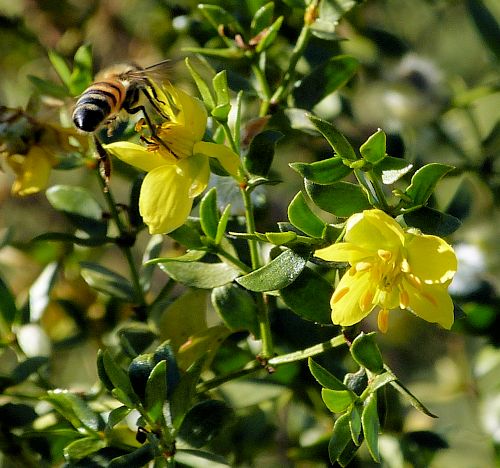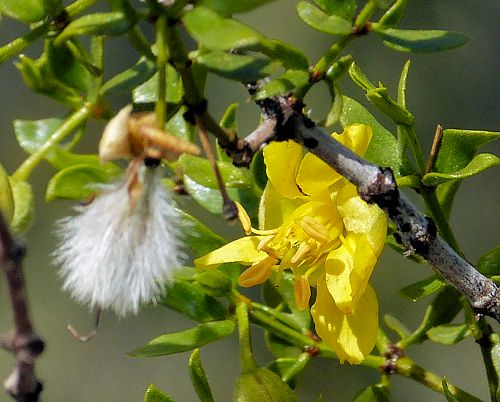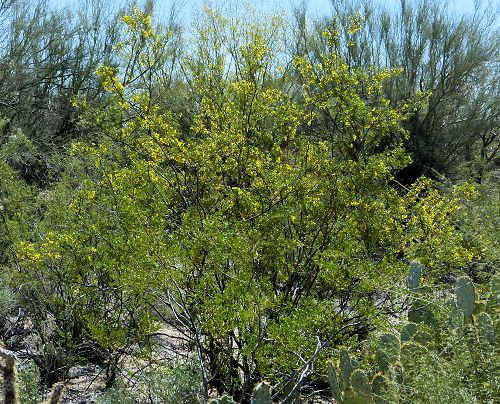Growing Larrea tridentata:
Creosote Bush
Description
Form: Shrub.
Lifespan: Several thousand years.
Leaf retention: Evergreen.
Growth rate: Slow.
Mature Size: 4-10' (1.2-3m) high and 6-12' (1.8-3.7m) wide.
Flowers: Yellow, with five wrinkled petals.
Bloom: Winter into spring, and sporadically after rains.
Fruit: A five-chambered seed capsule, covered in fine white hairs, that persists on the plant.
Leaves: Two shiny green leaflets joined at their base, with a resinous waxy surface, giving off a creosote smell after rain which some find enjoyable, others unpleasant.
Stems: Flexible, irregularly branched, no thorns.
Roots: Very aggressive, wide, with depth dependent on underlying caliche. New stems sprout from the root crown as clones of the original plant. Creosote Bush is difficult to transplant.
Wildlife: The flowers attract bees. This plant is host to Creosote Lac Scale, a tiny scale insect which produces lac and deposits it on creosote bush stems. Lac is pliable when heated, but hardens again on cooling, and can be used as an adhesive. The seeds attract jackrabbits and rodents. Most mammals avoid eating the foliage but jackrabbits may browse new stems.
Toxic / Danger: Poisonous to, and usually avoided by, grazing animals. The crushed leaves may cause a skin rash. It is unsafe as a home remedy.
Origin: California to Texas, Nevada, and Mexico.
Form: Shrub.
Lifespan: Several thousand years.
Leaf retention: Evergreen.
Growth rate: Slow.
Mature Size: 4-10' (1.2-3m) high and 6-12' (1.8-3.7m) wide.
Flowers: Yellow, with five wrinkled petals.
Bloom: Winter into spring, and sporadically after rains.
Fruit: A five-chambered seed capsule, covered in fine white hairs, that persists on the plant.
Leaves: Two shiny green leaflets joined at their base, with a resinous waxy surface, giving off a creosote smell after rain which some find enjoyable, others unpleasant.
Stems: Flexible, irregularly branched, no thorns.
Roots: Very aggressive, wide, with depth dependent on underlying caliche. New stems sprout from the root crown as clones of the original plant. Creosote Bush is difficult to transplant.
Wildlife: The flowers attract bees. This plant is host to Creosote Lac Scale, a tiny scale insect which produces lac and deposits it on creosote bush stems. Lac is pliable when heated, but hardens again on cooling, and can be used as an adhesive. The seeds attract jackrabbits and rodents. Most mammals avoid eating the foliage but jackrabbits may browse new stems.
Toxic / Danger: Poisonous to, and usually avoided by, grazing animals. The crushed leaves may cause a skin rash. It is unsafe as a home remedy.
Origin: California to Texas, Nevada, and Mexico.
Cultivation and Uses
USDA hardiness zones: 7-11.
Heat tolerant: Very tolerant.
Drought tolerant: Very tolerant.
Sun: Full sun.
Soil: Well draining, dry, low in organic content, not compacted, pH 6.6-9.0 (neutral to highly alkaline). It grows best on rocky ground.
Water after becoming established: It survives on annual rainfall alone where rainfall amounts are sufficient. Supplemental water every four months in drought is beneficial. The soil should dry out between waterings.
First Year Care: Young plants should be extensively watered when they first go into the ground, then watered weekly thereafter, and receive mostly part shade for the first three years. Young plants experience heat-caused drought stress very easily, and most do not survive without part shade and extra care.
Prune: After the danger of frost is past, Creosote Bush can be sheared into a hedge, a compact shrub, or a tree form. Trimming its stem tips makes it bushier and more attractive.
Litter: Low.
Propagation: Seed that is hulled, fumigated, and dried before storage, then scarified, and soaked in distilled water overnight before planting. Seedlings grown inside need to be hardened off, then transplanted to a desert location with part shade, especially afternoon shade, and protected from browsing animals to survive in their first three years.
Uses: Ornamental, hedge, low water (xeriscape) garden.
USDA hardiness zones: 7-11.
Heat tolerant: Very tolerant.
Drought tolerant: Very tolerant.
Sun: Full sun.
Soil: Well draining, dry, low in organic content, not compacted, pH 6.6-9.0 (neutral to highly alkaline). It grows best on rocky ground.
Water after becoming established: It survives on annual rainfall alone where rainfall amounts are sufficient. Supplemental water every four months in drought is beneficial. The soil should dry out between waterings.
First Year Care: Young plants should be extensively watered when they first go into the ground, then watered weekly thereafter, and receive mostly part shade for the first three years. Young plants experience heat-caused drought stress very easily, and most do not survive without part shade and extra care.
Prune: After the danger of frost is past, Creosote Bush can be sheared into a hedge, a compact shrub, or a tree form. Trimming its stem tips makes it bushier and more attractive.
Litter: Low.
Propagation: Seed that is hulled, fumigated, and dried before storage, then scarified, and soaked in distilled water overnight before planting. Seedlings grown inside need to be hardened off, then transplanted to a desert location with part shade, especially afternoon shade, and protected from browsing animals to survive in their first three years.
Uses: Ornamental, hedge, low water (xeriscape) garden.
Comments
This plant is a member of the Creosote Bush family (Zygophyllaceae).
There are desert locations with rainfall amounts too low for this plant to survive on its own.
Do you have additional information or a different experience for these plants that you would like to share? Email info@GardenOracle.com. All contributions are welcome and appreciated.
This plant is a member of the Creosote Bush family (Zygophyllaceae).
There are desert locations with rainfall amounts too low for this plant to survive on its own.
Do you have additional information or a different experience for these plants that you would like to share? Email info@GardenOracle.com. All contributions are welcome and appreciated.



Latest update: September, 2024
© 2008-2025 by GardenOracle.com

